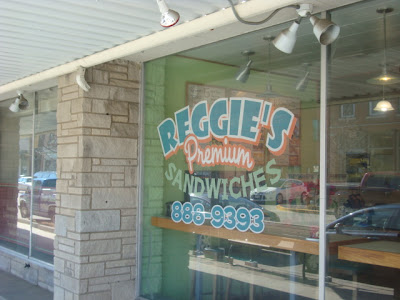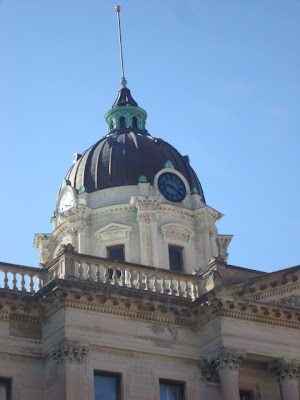Since Lincoln was right out, we visited some sites formerly unexamined by the Jabbo Exploration Team. I'll tell you all about them, but first, let's talk about National Historic Landmarks.
National Historic Landmarks
So far, we've been ticking off sites from the National Historic Register as we find them. However, within the ranks of the National Historic Sites, there exists an elite subclass, known as National Historic Landmarks. To rise to the status of Landmark, the site has to have National Level Historic Significance. The National Historic Register lists almost 90 thousand sites, and only 3% are National Historic Landmarks. You can find 25% of those in three states: Pennsylvania, New York, and Massachussetts (basically, where all the best stuff between 1600 and 1800 happened). Illinois has 85 (I've seen 6), Alabama has 37 (I've seen 1), Oklahoma has 22 (I think I've been to 1), and Texas has 46 (I've seen 14, 3 of those on my honeymoon).
To see the Landmarks in your state, check out this list:
http://en.wikipedia.org/wiki/List_of_National_Historic_Landmarks_by_state
Clover Lawn
We took Anne on her first Illinois Day Trip to the bustling Twin Cities of Bloomington-Normal. There, we found a National Historic Landmark that was only sort of Lincoln-related. Clover Lawn.
As you can probably tell, Clover Lawn looks like a hodgepodge of Victorian elements, a style known as Victorian Eclectic. It has a crested roof and asymmetrical facade, both common to all Victorian houses, but it has the Mansard of a Second Empire, the tower and bays often seen in Queen Anne, and the bold eaves of Italianate.
By the time David Davis commissioned Clover Lawn, he had made himself one of the richest men in Illinois. So rich, they had a masonry outhouse.
So rich, he had the money to get incredibly fat.
 |
| Public Domain |
They wouldn't let us take pictures of the interior, but the house was beautiful. And big. It even had a servants wing (I felt like I was touring Downton). The lady told us when the family tried to donate the house to the state, the state didn't want it. The state did want, however, the huge collection of correspondences between Davis and Lincoln sitting in the attic. The family said, you can have the letters, but you have to take the house with them. Which is the only reason the house is still standing.
Also standing are the original out buildings, including the coach house, which is also a Quilt Barn.
And before you ask...
Quilt Barns
I researched this and found the precise definitions required for Quilt Barnhood. A Quilt Barn is any barn or farm building that displays a Barn Quilt. A Barn Quilt is a wooden 8x8 ft. square painted with geometric or floral designs. Apparently this is a thing. There currently exist over 3 thousand Quilt Barns in 43 states and 2 Canadian provinces. Some say the tradition dates back to German immigrants in the 1830s, but the current popularity started when the first modern Barn Quilt went up in Adams County, Ohio in 2001. Several states have Quilt Barn Trails published online and you can follow them from barn to barn. Apparently, there are quite a few Quilt Barns in Oklahoma, but no one has created a list or a marked trail. That would be interesting for someone from Oklahoma to do. Compile an online list of Quilt Barns. Just saying.
Here's a good Quilt Barn site:
http://www.barnquiltinfo.com/
John W. Cook Hall
We couldn't go all the way to Bloomington without paying homage to another building funded by our favorite Progessive Patron, Governor Altgeld. That's right. Our second Altgeld Castle.
Built in 1898 as a Gymnasium (not the Greek kind), Cook Hall now houses the the School of Music for Illinois State University. Altgeld rejected the original plans for the building. He wanted it to look like one of the Rhineland Castles in Germany.
Here's Lahneck Castle on the Rhine for comparison:
 |
| Holger Weinandt |
Altgeld's architects acquiesced to his demands, but took some poetic license. They used Bedford Limestone on the exterior, limestone from a small area of Indiana. Limestone from the same vein was used on the Biltmore, the Empire State Building, and the Pentagon.
Art Deco Churches
Completely randomly, we happened to pass this church. I screamed until Aine pulled over to let me take a picture. This is the first and only Art Deco Church I've ever seen: Holy Trinity Catholic Church (it's also on the National Historic Register).
Though the US has several churches with Art Deco inspired elements, I could only find three Official Art Deco Churches. These include Madonna della Strada Chapel in Chicago and Christ the King Roman Catholic Church in Tulsa. Tulsa also has the Boston Avenue Methodist Church, both Art Deco and one of Oklahoma's National Historic Landmarks. (Apparently, Tulsa hit its second oil boom just in time to catch the Art Deco fad spreading across the US. As a result, Tulsa has enough Art Deco buildings to rival Chicago or New York, and an Art Deco museum to boot.)
A tornado wiped the original Holy Trinity off the map. The second one burned down in a fire. So you're looking at the third try. The Convent and Rectory building from the original structure (built in Richardsonian Romanesque) still stands behind the church. They are actually just left of this picture, but I didn't get them because I had no idea what I was doing.
Normal Theater
I saw this from the car and thought it might be important. I was totally right. National Historic Register site. The Normal Theater, dating back to 1937, was built in the Moderne style (a late version of Art Deco). Moderne features strong horizontal lines and rounded elements. MGM designed The Emerald City in the 1939 Wizard of Oz to look Moderne because that was the hottest new thing at the time. Go back and watch the movie: everything looks so Art Deco, it's disgusting.
Kroger
No joke. I took a picture of a grocery store. I didn't know you could find one north of Conroe. Apparently, Bloomington-Normal has one. Little known fact: Krogers have a unique Kroger smell that you can't smell in any other grocery store. A smell that makes me feel like I'm 16 again.
Uptown Girls
For lunch, we stopped in Uptown Normal, a trendy little main street area with shops and restaurants.
Anne said No Mexican Food. So we stopped at the locally renowned Reggie's Sandwich Shop.
Anne and Aine both got something boring with chicken, but I got the Chicago Style Beef. Mostly it tasted like a supreme pizza.
Anne hates having her picture taken, so I try to take as many pictures of her as possible. Here's one of my favorites from lunch.
Aine and I got in on the action too.
Downtown Man
After filling our bellies, we drove over to Downtown Bloomington, a city center somewhat more austere and old-timey than Uptown Normal. So, the McLean County Courthouse and surrounding square counts as one National Historic Site and then the entire business district around that counts as another.
The Courthouse itself lives on the site of three previous courthouses. It seems in Illinois, the life of a courthouse is cheap. The current one dates back to 1903, where it served in an official county capacity until 1976, the same year Bob Dylan released his album Desire, though I'm not sure the two events are connected. In 1976, the Courthouse became the headquarters for the McLean County Historical Society and the site of their museum.
I know what you're thinking. You're looking at those fluted columns with acanthus leaf capitals, that pedimented gable, the balustrade across the roof, that symetrical floor plan, and you're thinking, I'm looking at Neoclassical. Well, congratulations. You got this one, at least.
The business district includes the Ensenberger Building, built in 1926 to house Ensenberger's Furniture Store. Originally built as Gothic Revival with massive Gothic spires on the roof, the owner renovated the outside to look Art Deco in the 1940s. This place must have been special. It received 40 thousand visitors the week it opened, many coming from New York and California. Today it houses condos for the Bloomington Yuppie Class. The architect, Philip Hooton also designed the green terra cotta panels on the building's facade.
The venerable Mr. Hooton also designed the State Farm Building in 1929. That's three years later, so you don't have to do the math. As the name implies, this building served as the State Farm headquarters for Illinois for almost 50 years. Totally Art Deco.
On this next building, I found no information. As far as I can tell, it has no historical importance. I thought the copper Mansard looked sort of awesome, though.
Lincoln #15
In the shadow of the courthouse, we found another Lincoln, a 2000 work by Rick Harney.
Parting Shot
Here's your opportunity to play our favorite Champaign game: Find the Cat.























No comments:
Post a Comment